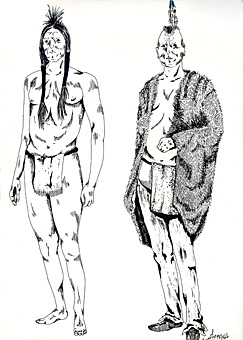first peoples
Agawam and Nonotuck
Nevertheless, through historical and archeological research, we are afforded a view into the lives of the Valley's original inhabitants. The cultural practices of these groups varied somewhat in their means of subsistence: uses of local flora and fauna, the kinds of tools available and their settlement patterns. However, the majority of these groups, known as Eastern Algonquian, shared similar languages, and were further connected through political alliances and kinship.
The Agawams and the Nonotucks were two of the groups that inhabited the Connecticut River Valley and some of the first to come into contact with English colonizers such as William Pynchon.
The seventeenth century Agawams of present day Springfield and the Nonotucks of present day Northampton are a study in contrasts. Both sold land to English settlers, the Agawams in 1636 and the Nonotucks in 1653. Eventually the Agawams (c.1655), in exchange for an English-built fort, sold their remaining planting grounds to them.
The Nonotucks sold acreage to the founders of Northampton. However, they were perhaps the first local Native People to resent the presence of the English, resisting further land sales and warning settlers not to hunt on their remaining lands. Living among them, and welcomed, were "rogues" (English-law breakers) who had fled the settlements.
Both groups fought the English in King Philip's War. In defeat many fled to French Canada, fighting as allies of the French against the English in the Connecticut River Valley until 1763.